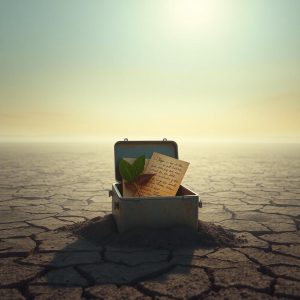 Scenario Prompt: In approximately 500 words, describe or narrate a scenario about a box found a few years into a future in which “progress” has continued. Your description should address issues related to the environment and elicit feelings of decadence.
Scenario Prompt: In approximately 500 words, describe or narrate a scenario about a box found a few years into a future in which “progress” has continued. Your description should address issues related to the environment and elicit feelings of decadence.
Scenario Results:
The Box in the Future
It was discovered on the edge of what had once been a forest, though by then the word “forest” had become a nostalgic term, used mostly in advertisements for synthetic retreats. The land was a patchwork of solar farms, vertical algae tanks, and the skeletal remains of trees that had been left standing as monuments to a vanished ecology. Amid this engineered landscape, a worker stumbled upon a box half‑buried in the soil—soil that was more dust than earth, laced with polymers from decades of “progress.”
The box was not remarkable in shape: a cube of tarnished metal, its hinges corroded, its surface etched with faint patterns that looked like vines. Yet the vines were not real, only decorative engravings, a reminder of nature’s image commodified long after nature itself had been stripped away. When the box was pried open, the air inside carried a faint sweetness, like the ghost of flowers. Within lay fragments: pressed leaves, brittle photographs of rivers, handwritten notes describing seasons. These relics seemed almost decadent, indulgent in their uselessness. Who, in this age of efficiency and optimization, would waste time recording the color of autumn or the sound of rain?
The discovery spread quickly. People came to see the box, not out of reverence but curiosity. Influencers posed beside it, their feeds filled with captions about “vintage vibes” and “eco‑aesthetic.” Corporations offered to purchase it, promising to display it in climate‑controlled galleries where visitors could pay to experience “authentic nature.” The box became a commodity, its contents auctioned in fragments: a single leaf sold for more than a month’s wages, a photograph of a river licensed for use in luxury advertising campaigns. Progress had continued, but it had hollowed out meaning, leaving only symbols to be consumed.
Around the box, the environment told its own story. The air was heavy with particulates from endless construction, though filtered masks made breathing tolerable. The rivers had been rerouted into pipelines feeding desalination plants, their surfaces shimmering with chemical films. Birds were rare, their songs replaced by drones that monitored crop yields. Yet people celebrated these changes as triumphs of human ingenuity. They spoke of abundance, of control, of a future free from uncertainty. The decadence lay not in excess of beauty, but in excess of consumption—every fragment of the past transformed into a luxury product, every reminder of nature packaged and sold.
The box itself became a mirror. Some saw it as a warning, others as an opportunity. A few whispered that it was sacred, that it carried the memory of balance, of humility before the earth. But their voices were drowned out by the spectacle: the gala events, the holographic projections of forests reconstructed from the box’s photographs, the endless marketing campaigns promising “eco‑luxury.” Progress had continued, yes, but it had become a spiral of decadence, where even loss was monetized, and even memory was consumed.
And so the box remained, displayed in a glass case, admired but not understood. Outside, the engineered landscape stretched endlessly, efficient and lifeless. Inside the box, pressed leaves crumbled slowly into dust, returning to the soil that no longer knew how to nurture them.
Reflection:
This scenario, “The Box in the Future,” offers a powerful and disturbing vision of a speculative future, skillfully designed to evoke feelings of decadence in a world dominated by a misguided notion of “progress.” It depicts a landscape where the relentless pursuit of optimization and efficiency has led to the systematic elimination of authentic natural experiences, replaced by carefully crafted, commodified imitations. The very fabric of the environment is transformed into a “patchwork of solar farms, vertical algae tanks,” with natural forests reduced to “nostalgic terms.”
The discovery of an ancient box containing fragments of a lost natural world, which held pressed leaves, photographs of rivers, and handwritten notes describing the seasons, serves as a powerful symbol. These relics, once common, become “almost decadent, indulgent in their uselessness,” emphasizing the deep shift in societal values. This story aligns with Dunne and Raby’s (2013) idea of comparing reality to ideals. As they argue “New ideas are exactly what we need today. Conceptual designs are not only ideas but also ideals, and as the moral philosopher Susan Neiman has pointed out, we should measure reality against ideals, not the other way around: ‘Ideals are not measured by whether they conform to reality; reality is judged by whether it lives up to ideals. Reason’s task is to deny that the claims of experience are final—and to push us to widen the horizon of our experience by providing ideas that experience ought to obey'” (p. 12). The box, in contrast to today’s engineered world, acts as such an ideal, revealing the emptiness of a future that has forgotten how to live in harmony with nature.
The true decadence of this future is not material excess but a profound loss of meaning. Nature becomes an “eco-aesthetic” brand, influencers market “vintage vibes,” and companies sell experiences that claim to be of “authentic nature.” Even memory and sentiment are monetized, with a single leaf worth more than a month’s wages. This future challenges us to reflect on our current path, urging us to question if our pursuit of progress is leading to a world where everything is functional and efficient but ultimately lacks genuine connection and intrinsic value, reducing most things to just a commodity.
References
Dunne, A., & Raby, F. (2013). Speculative everything: Design, fiction, and social dreaming. The MIT Press.